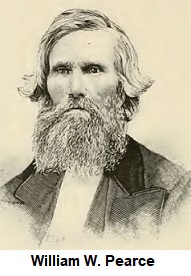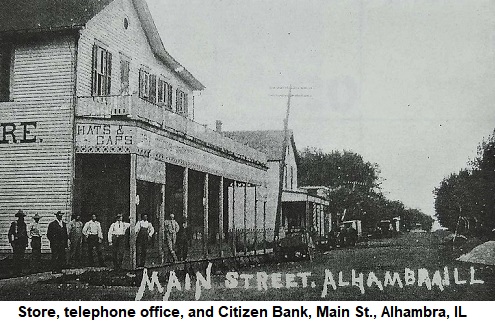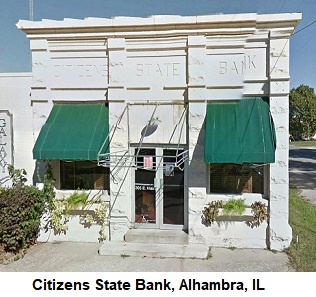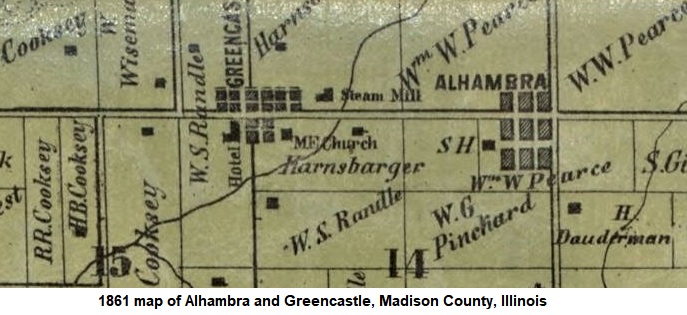Early History of Alhambra, Illinois
Click here for Alhambra newspaper clippings.
Alhambra was laid out in 1849 by Dr. Louis F. Sheppard, and the
plat recorded November 02, 1850. Sheppard came from the East with his
wife, Sarah Sheppard, and purchased considerable land in Madison
County. On their arrival, they made their home with Levi
Harnsberger. Mrs. Harnsberger and Mrs. Sheppard were reading
Washington Irving’s book, “Tales of the Alhambra.” The Alhambra
(meaning Red Castle) was a Moorish castle in Spain, and it was so
named because of its red-tiled exterior. When it was time to name
his newly established town, his wife suggested Alhambra, and he
approved.
William W. Pearce settled at Alhambra and purchased the holdings of
Dr. Southard. He laid out an addition of three blocks, north of the
original town. He was a large land holder and became a leading man
in Alhambra Township. In 1858, Pearce built a spacious brick
residence, the finest in the town, on Main Street. He was elected to
the State legislature in 1884.
Solomon Tabor and Louis F. Sheppard erected the first buildings in
William J. Lowry was the first postmaster of Alhambra. Lowry was a
farmer, living about two miles west of Alhambra. In 1846 or 1847, he
procured the establishment of a post office at his farm residence,
calling it “Lowry.” When Alhambra was laid out, he moved there, and
the name of the post office became “Alhambra.” The post office
changed several times between Alhambra and Greencastle, which was
one mile west of Alhambra. James B. McMichael moved the post office
to Greencastle, and afterward changed it back to Alhambra. R. D.
Utiger moved the post office to Greencastle in 1870, where he
maintained it until April 5, 1884, when Alhambra and Greencastle
combined and were incorporated under the name Alhambra. There had at
times been great rivalry between the two villages, but in times they
reconciled and become one.
The first schoolhouse in Alhambra was erected in 1856. In 1879, a
two-story frame schoolhouse was erected on the same site, where two
teachers were employed. In 1882, the town contained two general
stores (owned by Samuel Rosenthall and Leutweiler & Leuscheer; two
hotels (owned by John Ottenad and William Berg); two physicians
(Drs. F. M. Pearce and H. T. Wharff); two blacksmith shops (owned by
Chris Stait and Keintz Brothers); two wagon shops (owned by George
Schmidt and August Gross); a millinery and dress making shop (owned
by Mary J. Warderman); a barber (J. P. Pearce); two harness and
saddlers (H. Riffle and Casper Fridili); one hardware and
agricultural implement store (John Gehrig); and one tailor shop (V.
Deibert). In 1884 the village of Alhambra was incorporated, with F.
M. Pearce as mayor.
 In
1907, the citizens of Alhambra met and organized the Citizens’ State
Bank of Alhambra, with C. Tontz as president, Dr. C. E. Harnsberg
the first vice-president, and C. B. Munday the second
vice-president, and L. A. Schrieber as cashier. The stockholders
were comprised of thirty-six of the wealthiest
farmers of Alhambra Township. The directors of the bank were:
Christian Tontz, C. E. Harnsberger, C. B. Munday, August Talleur,
Herman Suhre, William Conrad, F. Oswald, N. L. Ryder, and W. H.
Beckman.
In
1907, the citizens of Alhambra met and organized the Citizens’ State
Bank of Alhambra, with C. Tontz as president, Dr. C. E. Harnsberg
the first vice-president, and C. B. Munday the second
vice-president, and L. A. Schrieber as cashier. The stockholders
were comprised of thirty-six of the wealthiest
farmers of Alhambra Township. The directors of the bank were:
Christian Tontz, C. E. Harnsberger, C. B. Munday, August Talleur,
Herman Suhre, William Conrad, F. Oswald, N. L. Ryder, and W. H.
Beckman.
Another bank was organized in 1907, and was the private institution
of
Alhambra became an important shipping point for grain and farm
produce. Dairy farms were a leading agricultural pursuit, with large
quantities of milk shipped daily to St. Louis, over the Illinois
Central and the Clover Leaf Railroads.
Greencastle
One mile west of Alhambra, Levi Harnsberger, W. S. Randle, and Henry
Harnsberger laid out the town of Greencastle on October 19, 1859. It
was often referred to as "lower town," and was located on the
corners of Sections ten, eleven, and fourteen in Alhambra Township.
Captain John Thornburg gave the village its name after Greencastle,
Indiana. The founders were farmers, and laid out the town on
adjoining parts of their farms. In 1860, John Thornburg erected a
store building, and opened a general stock of goods. The store
burned down in about 1865. John Gale built a store immediately
afterward, and commenced business there. In 1869, R. D. Utiger
rebuilt the Thornburg store and opened a general stock of goods.
Thomas Thornburg, William Lieserman, and John Gale built a grist
mill with two run of burrs. The mill was later owned by Pearce and
Matthews, and later moved to Palmer, Christian County, Illinois. A
Methodist Church was built in 1861. The German Evangelical Church
was moved to Greencastle from the Stepp neighborhood. It was used
for both church and school purposes. By 1882, it was used just for
the schoolhouse. A new church was erected on the same lot in 1878.
On April 5, 1884, Greencastle became part of Alhambra.
